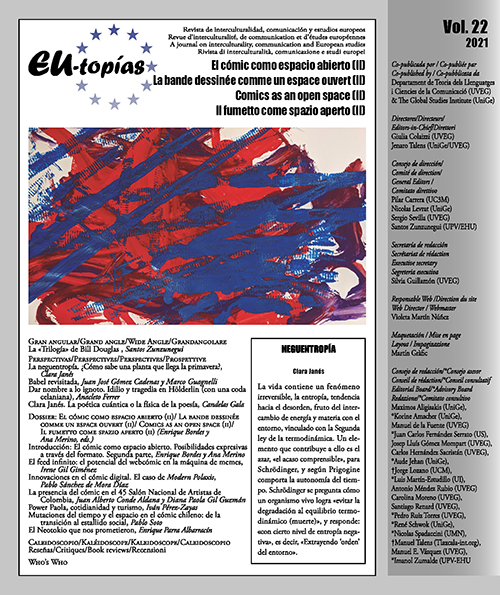Mutations of time and space in Chilean comics: from transition to social explosion
DOI:
https://doi.org/10.7203/eutopias.22.22933Keywords:
Time, space, graphic work, protest. Abstract
Abstract
There is a link between the forms of Chilean comics and the way in which political and social changes are manifested in the configuration of space in the city. The protests that ended the Pinochet dictatorship also created a movement of authors that came to an ending with the return of democracy. Afterwards, the social movements that took to the streets in the 21st century, and that produced the recent social outburst, have provoked Chilean cartoonists to look for a meeting point between the modernity of the graphic novel and the street pulse of the various social movements: there is a search to find a balance between reflection, testimony, the speed and spontaneity of the protest, as well in the large number of images and graphic works that appeared in the streets. Based on these reflections, this text seeks to analyze a corpus of works in which the political crisis is represented as a temporal and spatial problem —a way of inhabiting and taking charge of the past—, which is represented by the authors through the cartoon and the page as a space where both problems intersect.
 Downloads
Downloads
 References
References
Alcibiades Jofre, Manuel. «La historieta en Chile en la última década». CENECA, 1983, pp. 1-82, http://www.memoriachilena.gob.cl/602/w3-article-9867.html recuperado el 5 de enero de 2021
Arismendi, Gustavo. Cinta Cósmica: revista «Brígida», visibilizando a las mujeres del cómic. Youtube. 12 mar 2020. Web 20 enero 2021.
Bisama, Álvaro. Cien libros chilenos. Santiago: ediciones B, 2008.
Cornejo, Cristobál. Este jueves se lanza edición especial del cómic Martín Warp. El ciudadano. [Santiago, Chile] agosto. 2012: S.P. Web 15 ene. 2021.
Coogan, Peter. «The definition of the superhero». A Comics Studies Reader. Ed. Jeet Heer and Kent Worcester. Jackson: University press of Mississippi, 2009, pp.77-93.
Elizondo Abel y Videla Enrique. Martín Warp. Santiago: Mythica, 2012.
Espinoza, Camilo. «Cultura en el estallido». Podcast The Clinic. feb 2020. Web 20 enero 2021
García, Santiago. La novela gráfica. Bilbao: Astiberri, 2010.
Garcés, Mario. Estallido social y una nueva constitución política para Chile. Santiago: Lom, 2020.
Guerra, Felipe y Solar, Francisco. Rabia dulce de furiosos corazones: símbolos, íconos, rayados y otros elementos de la revuelta chilena. Santiago: Tempestades, 2020.
Lefévre, Pascal. «The construction of space in comics». A Comics Studies Reader. Ed. Jeet Heer and Kent Worcester. Jackson: University press of Mississippi, 2009, pp. 157-162.
Lobos, Themos. Las aventuras de Ogú, Mampato y Rena: Kilikilis y Golagolas. Santiago: Dolmen ediciones, 1996.
Lloret, Jordi y Araya, Rodrigo. Matucana 19. El garage de la resistencia cultural. Santiago: ocholibros, 2019.
Mayol, Alberto. El derrumbe del modelo. Santiago: Lom, 2017.
— Big Bang: estallido social 2019. Santiago: Catalonia, 2020.
McCloud, Scott. Entender el cómic. Bilbao: Astiberri, 2009.
Merino, Ana. El cómic hispánico. Madrid: Catedra, 2003.
Mitchell, W.J.T. ¿Qué quieren las imágenes? Bilbao: Sans Soleil, 2017.
Moulian, Tomás. Chile actual: anatomía de un mito. Santiago: Lom, 2017.
Mondzain, Marie-José. «La imagen entre procedencia y destino». Pensar la imagen. Comp. Emmanuel Alloa. Santiago: Metales Pesados, 2021, pp. 107 - 130
Morrison, Grant. Supergods. Madrid: Turner, 2012.
Muñoz, Gabriel. Revolución Pingüina: «¿Por qué luchábamos y cómo nos organizábamos en el 2006 los secundarios?» La izquierda diario [Santiago, Chile] 14 marzo.2020: S.P. Web 15 ene. 2021.
Olalquiaga, Celeste. Megalópolis. Santiago: Metales Pesados, 2014.
Romero, Nati. «Sensaciones». Revista Brígida 7. Ed. Marcela Trujillo y Sol Díaz Santiago: 2020
Rojas Flores, Jorge. Las historietas en Chile 1962-1982. Santiago: Lom, 2016.
Rojas, Sergio. Tiempo sin desenlace. Santiago: Sangría editores, 2020.
Salinas, Guido y Castro Sebastian. Que no pare la revolución. Santiago: autoedición, 2020.
Trabado Cabado, José Manuel. «La novela gráfica en el laberinto de los formatos del cómic». La novela gráfica. Poéticas y modelos narrativos. Comp. José Manuel Trabado Cabado. Madrid: Arco/libros,S.L, 2013, pp. 15-61
Uribe, Mario. (18-O) Psicoanálisis de un malestar: La Dignidad del sujeto. Santiago: Descontexto editores, 2020
Valle, Rafael. La gran aventura de Themo Lobos. Santiago: Sudamericana, 2014.
Viu, Antonia. Materialidades de lo impreso. Santiago: Metales Pesados, 2019.
Valenzuela, German. Entrevista a Abel Elizondo (Martín Warp). Youtube. 28 abril 2012. Web 21 enero 2021.
Downloads
Published
How to Cite
-
Abstract262
-
PDF (Español)213
Issue
Section
License
The authors conserve the copyright. All content published in EU-topías. Journal of interculturality, Communication, and European Studies are subject to the license Creative Commons Attribution-NonCommercial-ShareAlike 4.0 license. The full text of the license can be found at <http://creativecommons.org/licenses/by-nc-sa/4.0>
They may be copied, used, disseminated, transmitted and publicly displayed, provided that:
- The authorship and original source of the publication is cited (journal, publisher and URL of the work).
- They are not used for commercial purposes.
- The existence and specifications of this license of use are mentioned.
It is the responsibility of the authors to obtain the necessary permissions for images that are subject to copyright.



